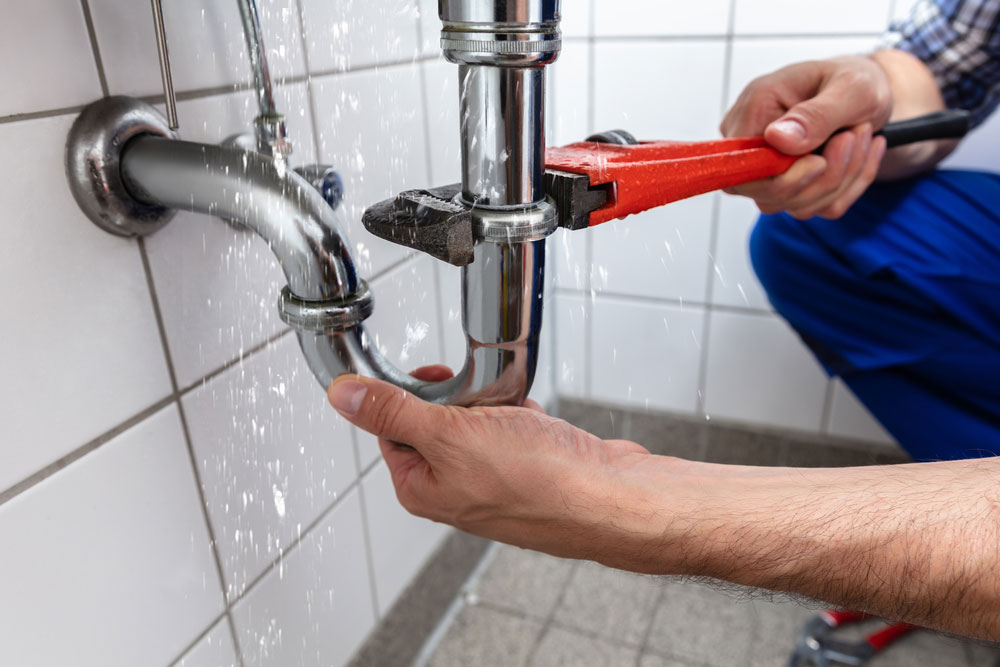
It’s quite common for your plumbing system to make banging noises. This happens when turning off a faucet or when water intake abruptly stops in the washing machine or dishwasher. The noise, known as “hydraulic shock”, is commonly referred to as “water hammer”.
Caused by water stopping or changing direction, the banging is the shock wave forcing plumbing pipes to strike each other or against wooden framing. Besides being frustrating, water hammer can be forceful enough to loosen your plumbing joints or even break pipes. Don’t deal with burst pipes on your own. Contact our expert plumbers today.
The good news is, it’s a problem that can be easily prevented. Here are four effective ways to eliminate water hammer.
If not properly secured, even the mildest shock wave can create a loud noise. But minor water hammer won’t cause problems. To prevent it, simply tighten all pipe straps on hangers that secure the studs or pipes to joists. Wrapping foam insulation around pipes can also absorb the shock that causes banging. It’s easy to do this in your basement or any exposed, unfinished space, as pipes are clearly visible and accessible.
If you notice any loose hangers or pipe straps, have them resecured. For added strength, add more hangers or pipe straps where pipes cross joists or studs. In areas where your plumbing pipes cross through bored holes in framing structural supports, simply pack insulation or more piping around pipes. Alternatively, you can cushion them using pipe sleeves.
In cases of severe water hammer, this method may not prevent pipe damage. Therefore, you will need to attempt one of the following methods.
Another easy way to eliminate water hammer is by installing a short vertical pipe close to the offending pipes. Commonly referred to as an “air chamber”, this fills pipe segments with air. This, in turn, creates a cushion for water when it suddenly changes direction. Generally, air chambers are created by plumbers (with regular fittings or pipes) as they install your plumbing system.
If not, you can also purchase a commercial air chamber. These are small pipe segments that are pre-capped.
Whichever option you choose, air chambers are made from a tee-fitting connected to the key plumbing pipe, with a short section of the horizontal pipe, leading to a segment of six-inch-long vertical capped pipe. Located away from the main water flow, this dead-end pipe traps an air pocket.
Once installed, when any water valve turns off abruptly, your air chamber temporarily compresses due to the pressure. This absorbs the shock which ordinarily causes water pipes to bang. Many people place air chambers next to the washing machine, the most obvious source of water hammer. However, we recommend installing air chambers throughout your home.
The key problem many face is if an air chamber fills with water, it stops functioning properly. You can easily correct this by regularly draining your water supply system, thereby flooding the chambers with air. To recharge the chamber:
Occasionally, air chambers are clogged by mineral build-up. However, this is easily cleaned by removing the caps and cleaning thoroughly. Clogging can also be prevented by opting for larger air chambers than your main plumbing lines.
This is a sophisticated way to absorb water hammer shock. It is an effective substitute for air chambers. A water arrestor is a sealed unit containing a spring and air bladder to absorb water movement, alleviating the impacts of water hammer. They are commonly used in commercial buildings and for high water pressure. Unlike air chambers, mechanical water arrestors don’t need recharging. However, they must be replaced once the bladders and inner springs wear out.
A water hammer arrestor can be easily placed in main sink faucets or washing machine valves. For easy installation, they have screw-on or compression fittings.
Another typical cause of water hammer is high water pressure from the main water pipe. Normally, water pressure should sit between 40-60 psi (aka pounds per square inch). Pressure exceeding this can cause serious water hammer. For optimum results, your water-pressure regulator should be located at the spot the main water supply enters your home. This ensures protection for all plumbing and fixtures from excessive water pressure.
First, test your water pressure to see whether it falls within the prescribed range. If a water-pressure regulator is needed, ensure the pressure sits below 50 psi.
Would you like more details on fixing water hammer? Simply see additional info on our website.
For more practical water hammer solutions, call or email Andrew J. Robertson Plumbing today.

Professional local plumbers you can trust. Call us for your domestic plumbing needs and you will not be disappointed.
Andrew J. Robertson Plumbing

Are you looking for a reliable professional for your plumbing needs?
Simply fill in the form below,
or call 0422 101 331.
"*" indicates required fields
Fill in this short form (takes 61 seconds) and we’ll contact you shortly.